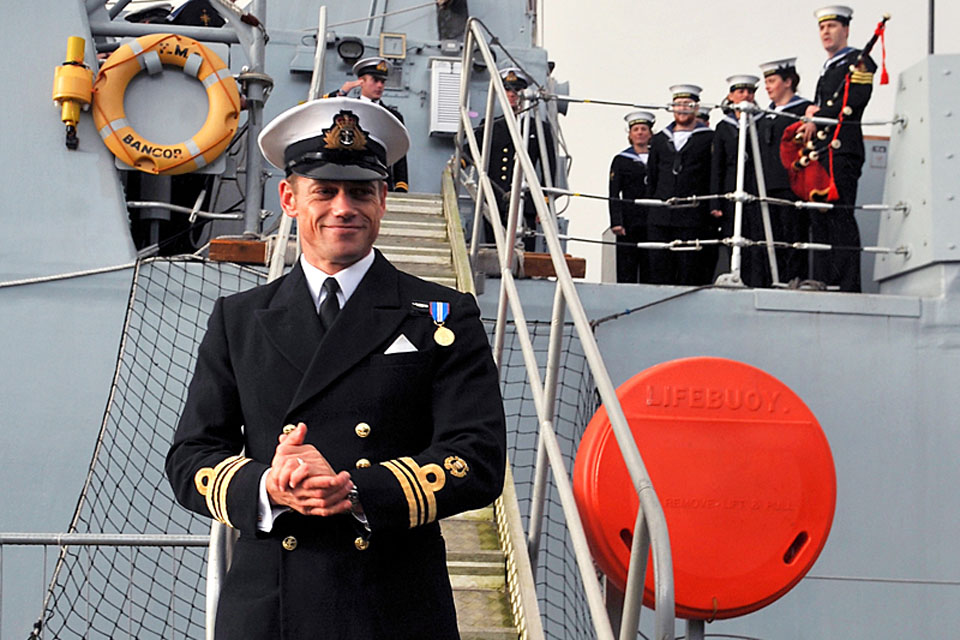HMS Bangor home from Libya mission
Royal Navy warship HMS Bangor returned home to Faslane today following 120 days of non-stop action supporting NATO operations off the coast of Libya.

A member of HMS Bangor's ship's company is welcomed home by his baby son at HM Naval Base Clyde, Faslane [Picture: Leading Airman (Photographer) Sally Stimson, Crown Copyright/MOD 2011]
The Faslane-based Sandown Class minehunter was welcomed home by families and friends as she sailed into HM Naval Base Clyde this morning, 25 November 2011.
Rear Admiral Chris Hockley, Flag Officer Scotland, Northern England and Northern Ireland, was on hand to congratulate the ship’s company on their latest deployment.
HMS Bangor sailed to the Mediterranean in June in support of NATO’s Operation UNIFIED PROTECTOR off Libya. Her tasks involved scouring miles of sea bed off the Libya coast as the battle between rebels and Colonel Gaddafi raged.
The painstaking work led to her finding a 2,400-pound (1,000kg) mine and a torpedo lying on the seabed off the port of Tobruk in eastern Libya. Both were safely destroyed using the ship’s Sea Fox system - an underwater drone armed with explosive charges.
HMS Bangor’s Commanding Officer, Lieutenant Commander Neil Marriott, said:
HMS Bangor’s ship’s company has produced some excellent results during the past five months off the coast of Libya and their efforts have significantly aided the safety of Libyan civilians.
They have spent in excess of 120 days at sea, of which 37 were within range of pro-Gaddafi forces’ weapons whilst clearing safe routes for merchant traffic and the delivery of humanitarian aid, and cleared two pieces of ordnance off the coast of Tobruk.

HMS Bangor's Commanding Officer, Lieutenant Commander Neil Marriott, steps onto dry land at Faslane after 120 days at sea [Picture: Leading Airman (Photographer) Sally Stimson, Crown Copyright/MOD 2011]
Bangor did not lose a single day’s work to defects or breakdowns during the summer, despite sailing hundreds of miles at a time and working round the clock. She was bound for NATO tasking in the North Sea at first, but reacted quickly to the higher priority work in the Mediterranean.
After the fall of Colonel Gaddafi’s regime, the operational pace dropped and Bangor was able to complete her final minehunting task into Sirte before commencing her journey home.
She stopped in Gibraltar off southern Spain last weekend, where sailors could run to the top of the Rock ahead of a remembrance service where a wreath was laid at the territory’s Cenotaph.
Lt Cdr Marriott said:
For many, this was their first operational deployment or time away from family and friends, and they are all deserving of their forthcoming leave following the very successful mission, for which they should be rightly proud.
Commander David Bence, the Commanding Officer of the First Mine Countermeasures Squadron at HM Naval Base Clyde, said:
Today sees Faslane welcome home a minehunter from active service in the Mediterranean. Her contribution to the NATO mission off Libya has been outstanding, and has been far in excess of expectations.
HMS Bangor’s ship’s company epitomise everything that is great about our men and women, from their stoic response to her short notice activation to the professional and flexible manner in which they conducted operations; the country, the Royal Navy and their families should be proud.
If HMS Bangor was made of oak rather than glass-reinforced plastic someone would write a song about her! Welcome home.
Operation ELLAMY, the codename given to the UK Armed Forces contribution to NATO’s Operation UNIFIED PROTECTOR, began on 19 March 2011 following the passing of UN Security Council Resolution 1973.
HMS Bangor was one of 16 ships from the Royal Navy and Royal Fleet Auxiliary which served during Operations DEFERENCE, ELLAMY and UNIFIED PROTECTOR off Libya.
At any one time 38 per cent of the Royal Navy’s mine countermeasures vessels flotilla is deployed on operations.